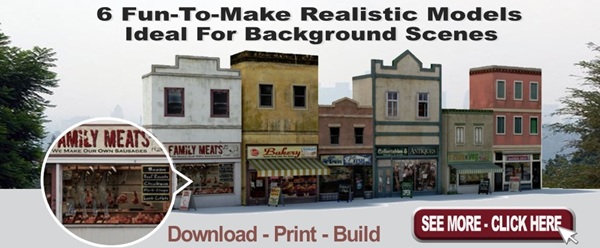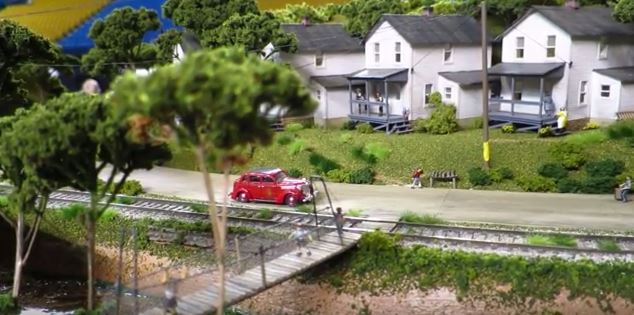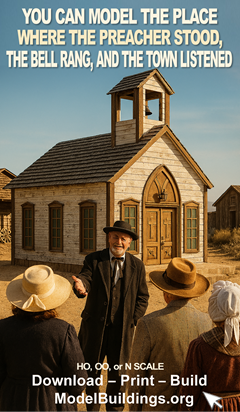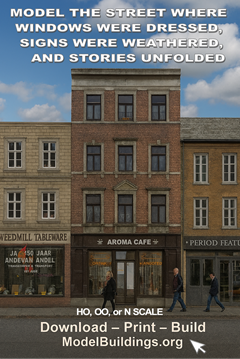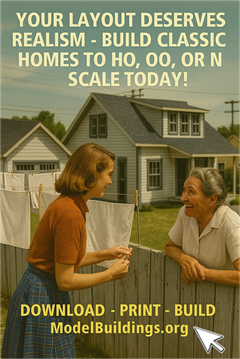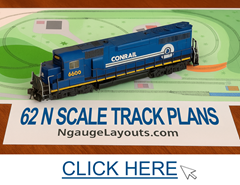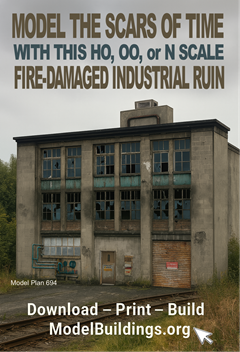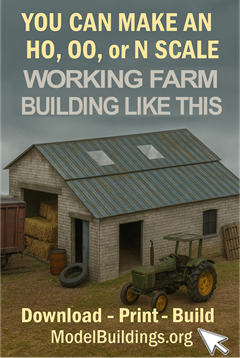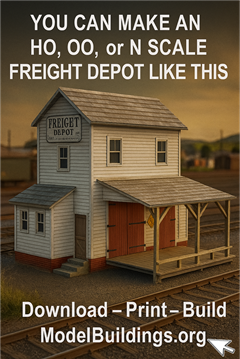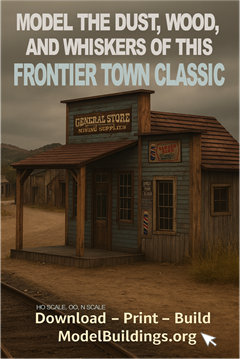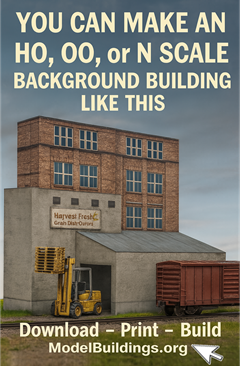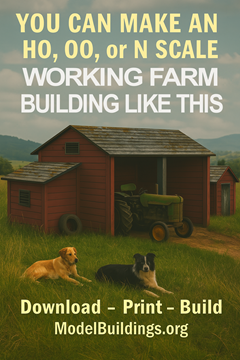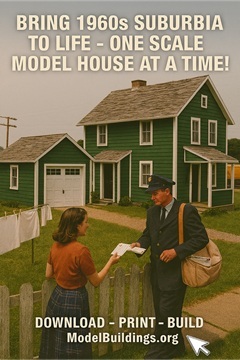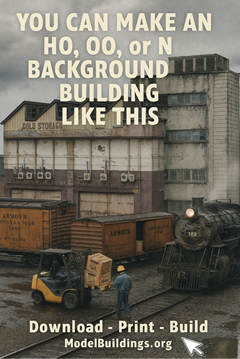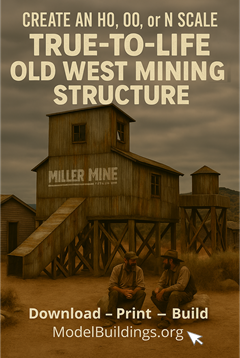Everything on model trains, model railroads, model railways, locomotives, model train layouts, scenery, wiring, DCC and more. Enjoy the world's best hobby... model railroading!
Build Smart: Why Modular Model Train Layouts Might Be Your Best Move
Build Smart: Why Modular Model Train Layouts Might Be Your Best Move
If you love model trains but don’t have the space, time, or patience for a massive, permanent layout, a modular approach might be the perfect solution. Modular train layouts are built in sections, which means you can create your railroad empire one piece at a time, and rearrange it whenever inspiration strikes.
They’re flexible, portable, and easier to manage than a full-size build. But they also come with a few quirks that can trip you up if you’re not prepared. So, let’s look at the pros and cons, followed by the 7 biggest mistakes to avoid (some of which I’ve made myself).
Why Go Modular?
1. Flexibility
This is the number one reason hobbyists go modular. Each module is like its own mini-layout, so you can experiment freely. Want a mountain next to a city yard? Easy. You can swap sections or expand your layout whenever you like.
2. Portability
Moving house or attending a show? No problem. Modular layouts are designed to come apart and travel easily. That’s a major plus if you don’t want your spouse glaring at a ten-foot freight yard taking over the living room!
3. Manageable Workload
Building in sections makes the process less overwhelming. You can focus on detailing one part, learn as you go, and celebrate small victories along the way.
4. Easier Repairs and Upgrades
If something breaks, you don’t need to dismantle your entire railroad. Just remove the affected module, work on it at your bench, and pop it back in place.
A Few Downsides
Connection Challenges – Getting track joints perfectly aligned between modules can be tricky. Even a millimeter off and you’ll have derailments galore.
Storage Needs – You still have to store the unused sections, and some modules can be bulkier than you expect.
Uniformity Limits – If you plan to connect with others at clubs or shows, you’ll need to follow their standards for height, track position, and wiring.
7 Big Mistakes to Avoid When Building Modular Train Layouts
- Not Planning for Interconnection – Always plan how your modules connect: track alignment, wiring, and scenery transitions.
- Ignoring Standards – If you ever plan to exhibit, follow club specs or your module might not fit.
- Making Modules Too Big or Heavy – Stick to 2–4 feet in length for easy handling.
- Skipping Test Fits – Always test alignment before gluing or screwing parts permanently.
- Overcomplicating the Wiring – Keep wiring neat, labeled, and standardized.
- Weak Framing – Each module should be rigid and well-braced to prevent flexing or warping.
- No Transport Protection – Add handles, protect scenery, and use transport boxes if you’ll move them often.
Smart, Flexible Model Train Modular Layouts
Modular model railroading is a smart, flexible way to enjoy the hobby without the stress of committing to one giant layout. It’s easier to move, upgrade, and store… and it keeps the fun alive as you grow your railroad over time.
Just plan ahead, stay organized, and avoid those common mistakes. You’ll have a layout that’s not only fun to build but easy to take wherever your hobby takes you.
? Download your free Model Builders Catalog today: https://www.modelbuildings.org
Great Getting Started in N SCALE Resource
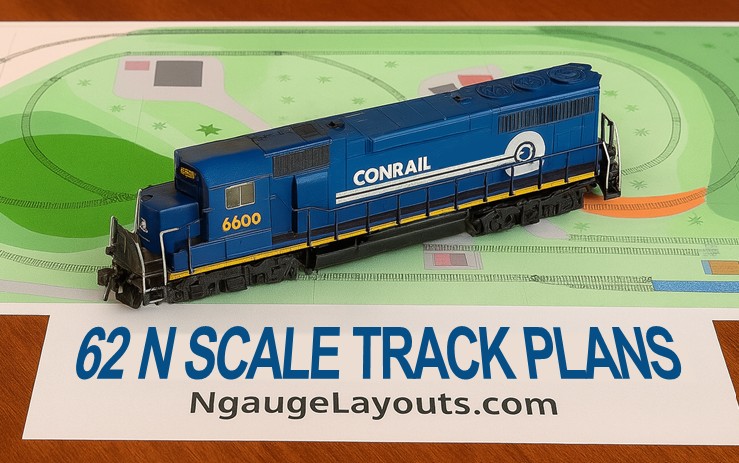
Choose from 62 N SCALE TRACK PLANS to suit any space from 3ft x 2ft table tops, 4ft x 2ft module designs, through to truly inspiring room-sized layouts! And, you can easily adapt any of the plans around your favorite railroad theme.
See more https://ngaugelayouts.com
Why the 1960s Remain a Favorite Era for Model Railroaders
When model railroaders choose an era for their layout, the 1960s consistently rise to the top. This decade offered so much… variety in locomotives, evolving industries, striking colors, and an intriguing mix of the old and the new. It’s an era that captures a real sense of change, and that’s part of what makes it so fascinating to model.
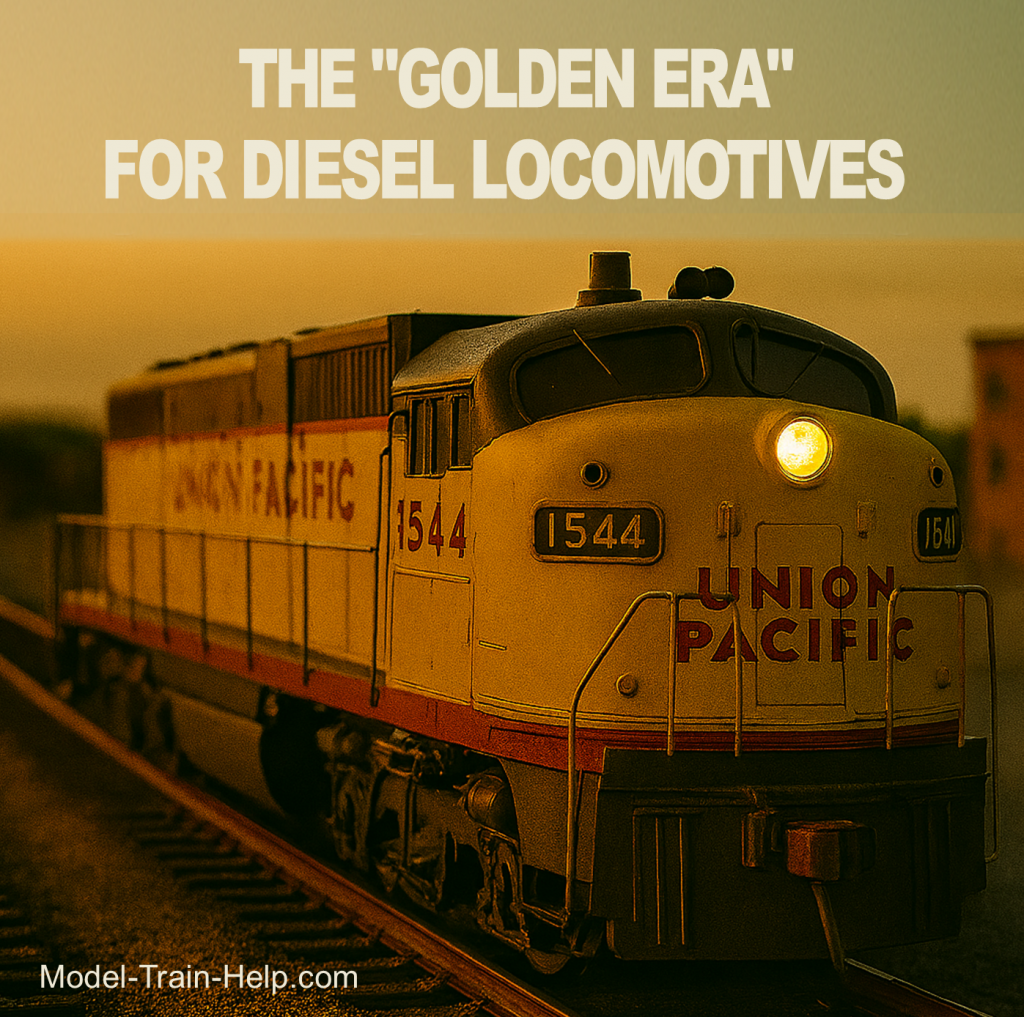
A Dynamic Transition Period
The 1960s marked a major turning point in railroad history. Steam locomotives had mostly disappeared, but traces of them remained in smaller branch lines. First-generation diesel locomotives were still hard at work, while sleek new second-generation diesels were rolling out across the country. That blend of eras gives modelers tremendous flexibility.
A 1960s layout can feature everything from early EMDs and Alcos to emerging GP30s or SD40s. Freight cars varied in both size and style… 40-foot boxcars alongside newer 50-foot types creating visual diversity without breaking authenticity. Modelers can mix and match equipment from the late 1950s through early 1970s and still remain believable.
This flexibility is one of the key reasons so many modelers enjoy recreating this time. It’s a period that feels complete but not confined… full of operational and visual possibilities.
The Look of a Changing America and Europe
The 1960s were also an era of enormous change in the built environment. Old brick warehouses still dominated many industrial districts, but modern concrete plants, glass-fronted offices, and suburban expansion were rapidly reshaping towns and cities.
That contrast gives a layout real depth. A small 1960s town could include an older freight depot, a new supermarket, a downtown gas station with modern signage, and a few tired-looking factories showing their age. The vehicles, too, tell a story… gleaming new Chevrolets (if you are modelling a US scene) beside older Fords still running strong.
Railroads themselves were also experimenting visually. Bright, modern paint schemes replaced the subdued tones of earlier decades, and company logos became bolder. For modelers, that means more color, more variation, and plenty of room for creativity when weathering and detailing locomotives and rolling stock.
Operations and Realism
Operationally, the 1960s provide some of the most interesting possibilities. Railroads were still serving local industries… grain elevators, small warehouses, lumber yards, and team tracks were common. Passenger service was declining but hadn’t yet disappeared entirely, and mail or express runs could still be modeled authentically.
Freight cars were generally shorter and locomotives smaller compared to modern equipment, which makes the 1960s perfect for modelers working with limited layout space. Trains look right on modest curves and shorter sidings, yet operations can still be realistic and engaging.
A Dynamic Transition Period
The 1960s marked a major turning point in railroad history. Steam locomotives had mostly disappeared, but traces of them remained in smaller branch lines. First-generation diesel locomotives were still hard at work, while sleek new second-generation diesels were rolling out across the country. That blend of eras gives modelers tremendous flexibility.
A 1960s layout can feature everything from early EMDs and Alcos to emerging GP30s or SD40s. Freight cars varied in both size and style… 40-foot boxcars alongside newer 50-foot types creating visual diversity without breaking authenticity. Modelers can mix and match equipment from the late 1950s through early 1970s and still remain believable.
This flexibility is one of the key reasons so many modelers enjoy recreating this time. It’s a period that feels complete but not confined… full of operational and visual possibilities.
The Look of a Changing America and Europe
The 1960s were also an era of enormous change in the built environment. Old brick warehouses still dominated many industrial districts, but modern concrete plants, glass-fronted offices, and suburban expansion were rapidly reshaping towns and cities.
That contrast gives a layout real depth. A small 1960s town could include an older freight depot, a new supermarket, a downtown gas station with modern signage, and a few tired-looking factories showing their age. The vehicles, too, tell a story… gleaming new Chevrolets (if you are modelling a US scene) beside older Fords still running strong.
Railroads themselves were also experimenting visually. Bright, modern paint schemes replaced the subdued tones of earlier decades, and company logos became bolder. For modelers, that means more color, more variation, and plenty of room for creativity when weathering and detailing locomotives and rolling stock.
Operations and Realism
Operationally, the 1960s provide some of the most interesting possibilities. Railroads were still serving local industries… grain elevators, small warehouses, lumber yards, and team tracks were common. Passenger service was declining but hadn’t yet disappeared entirely, and mail or express runs could still be modeled authentically.
Freight cars were generally shorter and locomotives smaller compared to modern equipment, which makes the 1960s perfect for modelers working with limited layout space. Trains look right on modest curves and shorter sidings, yet operations can still be realistic and engaging.
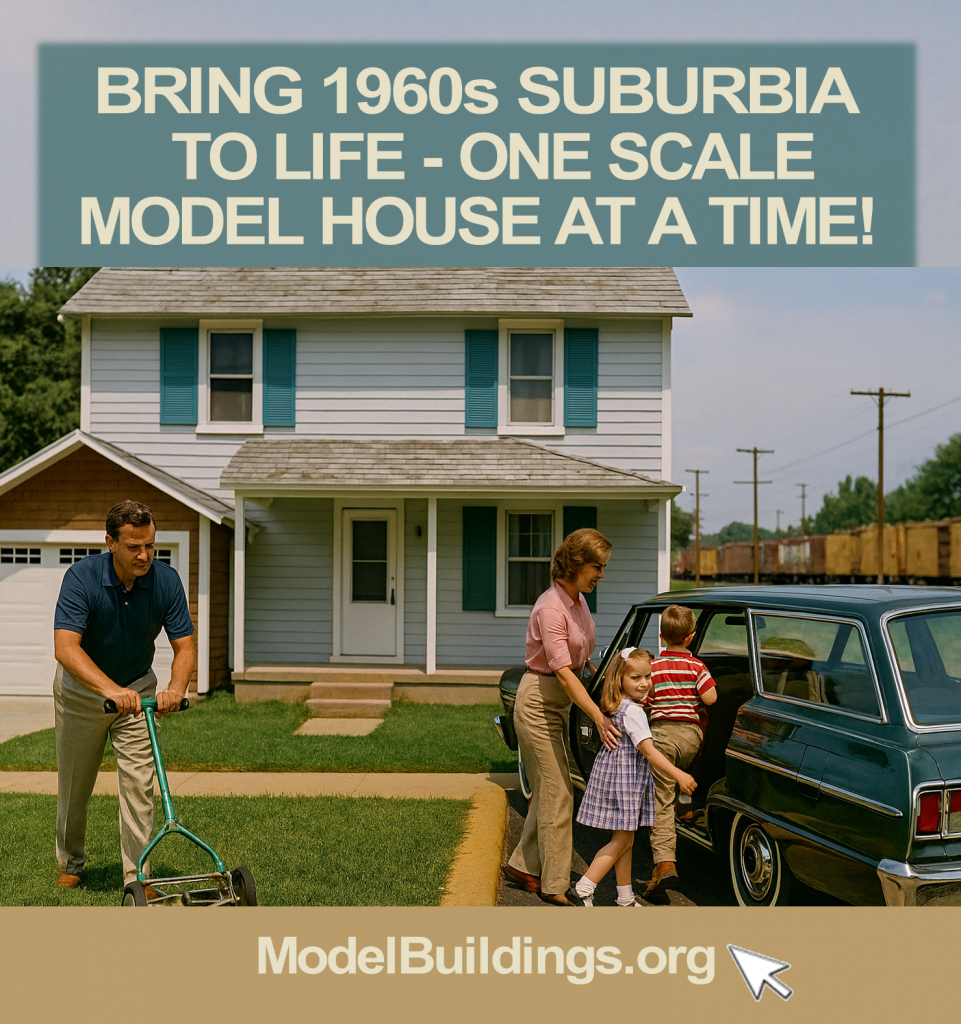
Kits, Costs, and Modern Alternatives
Back in the 1960s, the model railroading hobby itself was going through a transformation. That decade saw a surge in plastic kits and greatly improved molding techniques, allowing hobbyists to build more detailed locomotives, rolling stock, and structures than ever before. Those kits were revolutionary at the time, but they can be expensive to today, and even modern versions often require painting, airbrushing, and detailing to bring them up to a realistic standard.
Because of that, many modern hobbyists have turned to photo-realistic downloadable kits and printable building plans as a cost-effective, time-saving alternative. These printed models can be pre-weathered, scaled for HO, OO, or N gauge, and easily customized. They offer the realism of detailed textures and subtle weathering without needing a spray booth or airbrush setup.
A great resource for this approach is ModelBuildings.org, where you can instantly download and print 1960s-era houses, factories, warehouses, and railroad structures. These designs capture the authentic look of mid-century architecture and are perfect for blending older brick buildings with newer modern additions, exactly what you’d expect to see in a 1960s town or industrial area.
Capturing the Spirit of the Era
To make your 1960s layout really come alive, study real-world photos from the time. Note how buildings were beginning to show age… faded paint, cracked signs, weather-worn brickwork… and how modern elements crept in, such as fluorescent signage or aluminum trim. Mix those contrasts freely.
You can also blend rolling stock from different railroads, as mergers hadn’t yet consolidated the rail scene. That gives you a vibrant mix of logos, colors, and car types. Add realistic details like period automobiles, telephone poles, mailboxes, and advertising signs, and the setting will instantly transport your viewers back in time.
Recreate a World full of Character, Industry, and Life.
The 1960s offer the perfect “sweet spot” for model railroaders: just modern enough to feel familiar, yet old enough to retain the grit and charm of classic railroading. It’s a time of change, color, and contrast… and for modelers, that means endless creative opportunities.
Whether you prefer building plastic kits or using photo-realistic printable structures from ModelBuildings.org, this era rewards imagination and attention to detail. The 1960s aren’t just history, they’re an invitation to recreate a world in motion, full of character, industry, and life.
All Aboard! Discover the Magic of Model Railroading
Step into a world where imagination meets craftsmanship, and tiny trains tell big stories. Whether you’re a curious beginner or someone rediscovering a childhood passion, model railroading offers a hands-on adventure that’s as rewarding as it is fascinating. This guide will help you explore the many layers of this captivating hobby, and maybe even inspire your first layout!
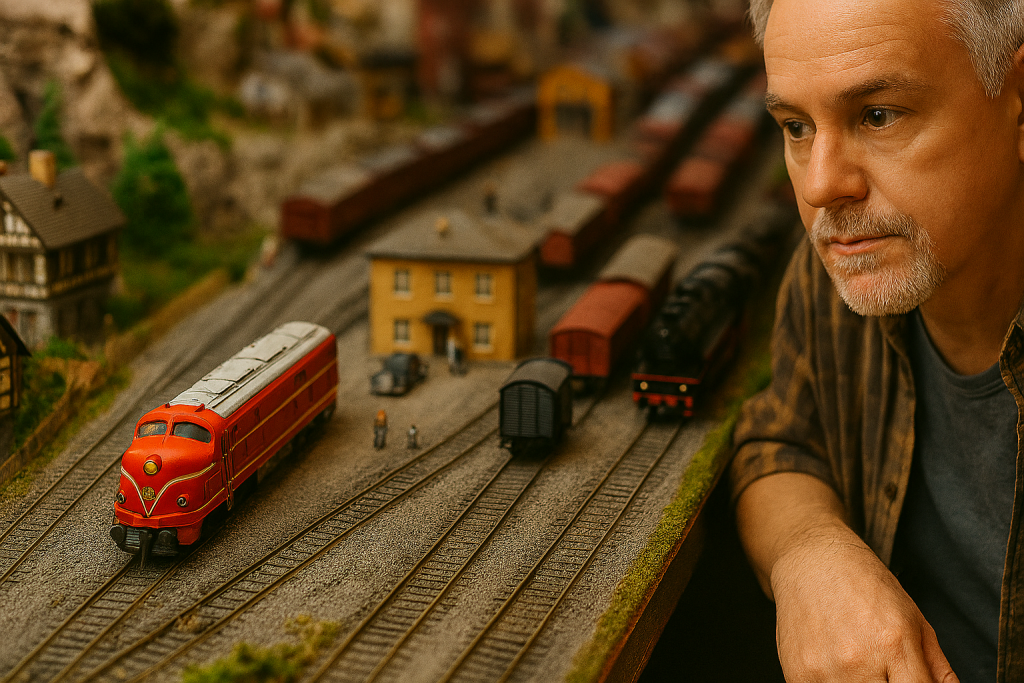
Why Choose Model Railroading?
Often called “the world’s greatest hobby,” model railroading earns its title by blending a wide range of interests and skills. It’s not just about trains… it’s about building entire worlds in miniature, solving technical puzzles, and expressing your creativity in ways that are both personal and shareable.
Ask a few enthusiasts what draws them in, and you’ll hear answers as varied as the railroads themselves:
- Nostalgia: Recreating scenes from childhood or honoring historical railways.
- Craftsmanship: Designing realistic landscapes, towns, and train stations with incredible detail.
- Engineering: Tackling the challenges of wiring, automation, and digital control systems.
- Storytelling: Every layout tells a story… whether it’s a bustling city in the 1950s or a quiet countryside in modern times.
A Hobby That Has It All
Model railroading touches on:
- Artistic design: Scenery, painting, and layout planning.
- Technical know-how: Electronics, mechanics, and digital programming.
- Historical interest: Learning about real railroads and their evolution.
- Social connection: Joining clubs, attending exhibitions, and sharing your work online.
- Personal reflection: Quiet hours spent building, tinkering, and dreaming.
It’s a hobby that welcomes all ages and backgrounds. Whether you’re 9 or 90, there’s joy to be found in laying track, running trains, and watching your miniature world come to life.
From Steam to Silicon: A Journey Through Time
Exploring model railroading is like stepping into a time machine. You can recreate the golden age of steam, experiment with futuristic bullet trains, or blend eras to suit your imagination. As real-world rail technology evolves, model railroading keeps pace… offering new tools, materials, and digital systems to enhance your layouts.
So, bring your sense of wonder. This hobby isn’t just about trains… it’s about the stories they carry, the worlds they connect, and the joy of building something truly your own.
Building the Wild West: How Railroads Shaped Frontier Towns and Inspired Model Railroaders
If you’ve ever been captivated by a classic Western… complete with saloon brawls, dusty cattle drives, train robberies, and tense showdowns between outlaws and lawmen… then you already understand the allure of the Wild West. It’s no surprise that so many model railroaders choose this iconic era as the centerpiece of their layouts. There’s something timeless and romantic about the frontier spirit, even though life for early settlers was anything but easy.
Creating a Wild West town on your model railroad layout is a chance to blend history, storytelling, and craftsmanship. It’s about more than just trains… it’s about capturing the grit and charm of a bygone era.
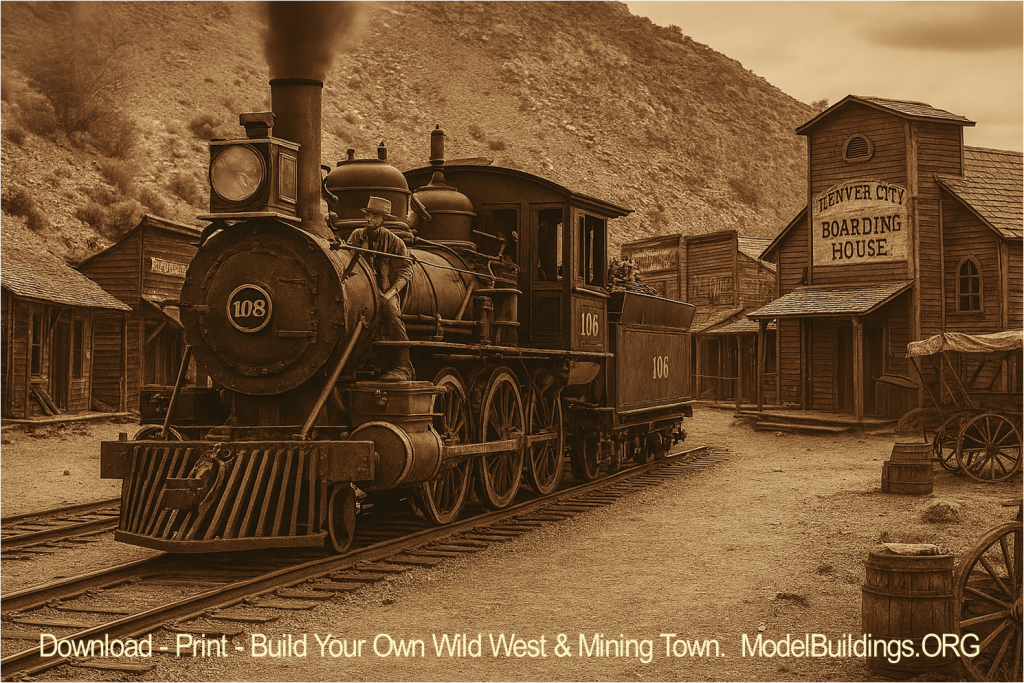
What Makes a Wild West Town Come Alive?
To build an authentic Wild West scene, you’ll want to include the essentials: a saloon (or two), a sheriff’s office and jail, a blacksmith, a general store, a gunsmith, and of course, a bank. These were the lifeblood of any frontier town. Add a hotel or boarding house for weary travelers, and maybe a church or school to round out the community. And yes, more saloons are always welcome… after all, that’s where the action happened (especially for the menfolk).
For added realism, consider placing your town near a mining camp, a ranch, or a railroad station with a telegraph office. These elements help tell the story of expansion, commerce, and survival in the untamed West.
If you’re looking for ready-to-print buildings to bring your layout to life, check out
https://www.modelbuildings.org/wild-west-mining
The downloadable kits are perfect for crafting detailed scenes with period-accurate architecture and signage.
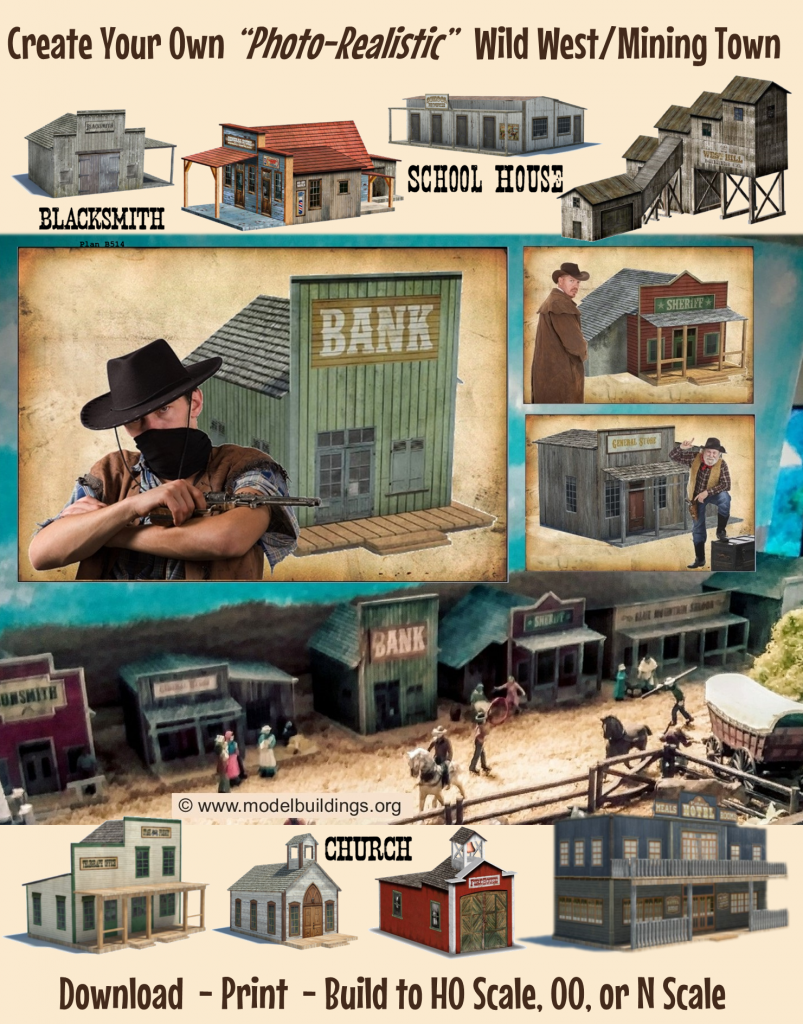
A Brief History of Railroads in America
Railroads first took shape in England, thanks to pioneers like George Stephenson, whose steam engines revolutionized transportation. It wasn’t long before American entrepreneurs saw the potential and began importing both engines and rails from England. Before the Civil War, much of the infrastructure was still sourced overseas.
But once the idea took root, the United States embraced railroads with gusto. The ability to move goods, people, mail, and even gold across vast distances was a game-changer. Compared to slow, dangerous stagecoach journeys, trains offered speed, safety, and efficiency.
Railroads didn’t just connect cities… they transformed the entire country. Economically, socially, and politically, the U.S. was reshaped by steel rails and steam engines. Over the next fifty years, America saw a boom in infrastructure: bridges, tunnels, telegraph lines, and train stations sprang up to support the growing network.
Challenges on the Frontier
Of course, building railroads across rugged terrain wasn’t easy. Financing was a constant hurdle, and opposition came from all sides… stagecoach operators, canal companies, turnpike owners, and even saloon keepers who feared losing business. In some cases, resistance turned violent, with sabotage targeting tracks and equipment.
Despite these challenges, the railroads pressed on. The promise of progress was too strong, and the benefits too great.
Train Robberies: The Wild West in Action
If you’ve seen a Western movie, you’ve probably watched a gang of outlaws rob a train. These scenes weren’t just Hollywood fiction… they were based on real events. As trains replaced stagecoaches, criminals adapted their tactics. Gangs targeted gold shipments, payrolls, and passengers, often striking in remote areas where law enforcement was days away.
Some robbers placed obstacles on the tracks or removed wooden ties to derail trains. Others rode alongside on horseback, leaping aboard while their partners held the reins. Once onboard, they’d unhitch the rail cars, blow open safes with dynamite, and make off with the loot. In some cases, gang members posed as passengers, waiting for the right moment to seize control.
Railroads like Southern Pacific, Union Pacific, and Central Pacific took these threats seriously. Security became a top priority, and companies like Wells Fargo were heavily impacted.
Famous Outlaws of the Rails
The Wild West had no shortage of legendary train robbers. Jesse James and the James Gang were among the most notorious, followed by Butch Cassidy and the Wild Bunch. In one infamous heist, the Wild Bunch used too much dynamite and accidentally blew $30,000 into the air.
Law enforcement agencies like the Texas Rangers, Pinkerton detectives, and U.S. Marshals worked tirelessly to track down and prosecute these criminals. Their efforts helped bring a measure of order to a lawless frontier.
Bringing History to Life on Your Layout
Model railroading offers a unique way to explore this rich history. By recreating Wild West towns and mining camps, you’re not just building scenery… you’re telling stories. Every building, every train, every tiny figure adds to the narrative.
Whether you’re drawn to the drama of train robberies, the charm of dusty saloons, or the ingenuity of early railroads, there’s a place for it on your layout. And with printable downloaded kits from https://www.modelbuildings.org, it’s easier than ever to bring your vision to life.“When steam met steel, the Wild West was never the same.” From dusty trails to iron rails, railroads didn’t just connect towns… they built legends. Explore the range on the website under the category Wild West / Mining.
? ???????? ? ??????? ???’? ???????? ?????? & ?????!
Build Smart: The Ideal Height and Width for Your Model Railroad Layout
When it comes to building a model train layout, most people focus on track plans, scenery, or wiring. But here’s something just as important: the height and width of your layout. Get this wrong, and you’ll be uncomfortable, frustrated, and possibly even damaging your hard work.
Finding the Right Height
The “perfect” height depends on how you enjoy the hobby. If you like standing back and watching the trains roll by, a higher layout… around 48 to 52 inches… gives you that eye-level view of scenery and operations.
But if you’re more into hands-on switching and operations, go a bit lower… around 40 inches… so you can easily reach in and manipulate cars, track switches, and scenery.
Got kids or grandkids involved? Think lower still, maybe 30 to 36 inches, so they can see the action without struggling.
Don’t Overstretch the Width
Width (or depth) is just as critical. A layout against a wall should stay between 24 to 30 inches deep so you can comfortably reach every spot. Anything more, and you’ll find yourself climbing over scenery to fix derailments or uncouple cars. Obviously, the scale you are building and operating is a consideration.
For U-shaped or island-style layouts, you can go wider… 36 to 48 inches… since you’ll have access from multiple sides. Always test your reach first: can you get to every spot without leaning too far or damaging scenery?
Plan for the Future
Remember, higher benchwork shortens your reach, and none of us is getting younger. If possible, build access holes or design your layout so it can be reached from more than one side. Maintenance is part of the hobby, so plan smart now, and you’ll enjoy smoother operations for years to come.
? Pro Tip: Download your free Model Builders catalog here: https://www.modelbuildings.org
1. Benchwork Building
- In the planning section: “higher benchwork shortens your reach” → “benchwork”
Picking the Right DCC Decoder with Sound for a Conversion
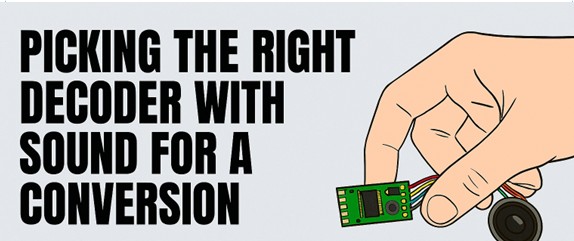
Luis asks readers:
“I’m upgrading my layout from DC to DCC and want to start by converting a few engines. How do I figure out which decoder and sound setup is right for each locomotive? Any advice on matching the right parts?”
You can add your comments and thoughts under this post.
Magic: How This Tiny Town Packs in Big Detail
N scale might be small – but the possibilities are massive.
This layout proves that you don’t need a spare garage to build something breathtaking. With a footprint barely larger than a card table, this miniature town delivers realism, charm, and operational interest in every square inch.
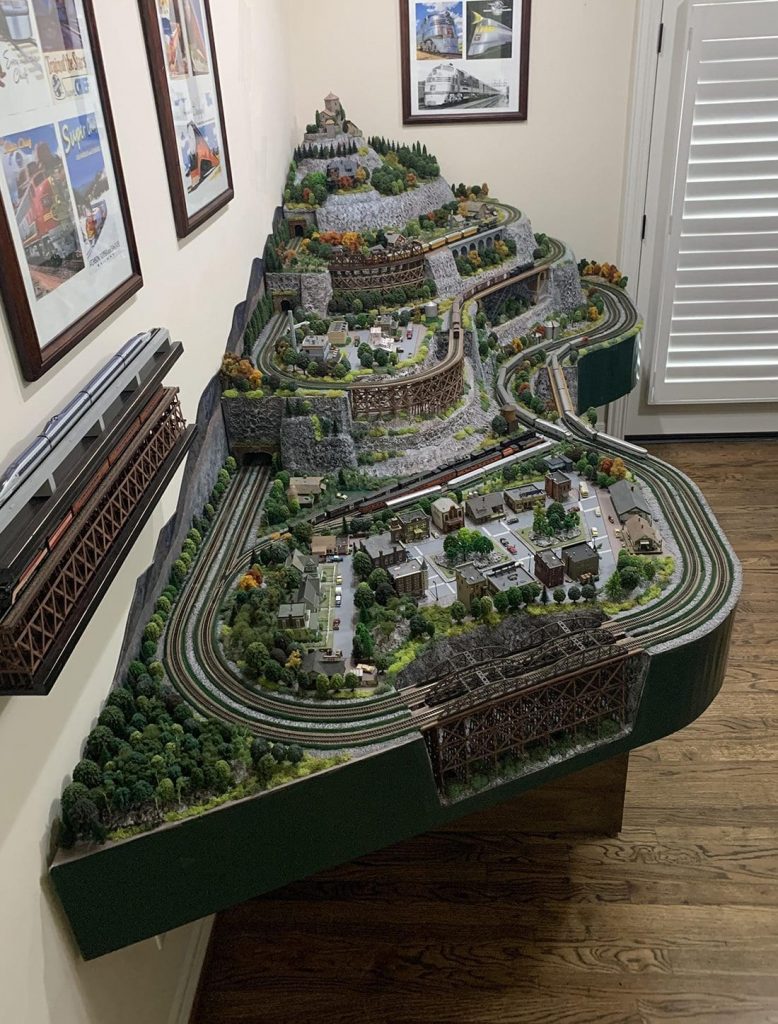
This image showcases the kind of detail possible in N scale – from layered terrain to realistic trackwork and scenic integration. Here’s how the builder made it work — and how you can too.
? 1. Smart Compression
Instead of cramming everything in, the builder chose a theme: a rural town with a freight spur and a passenger depot. Selective compression allowed:
- A believable main street
- A small industry with switching potential
- A scenic backdrop that suggests more beyond the layout
- CLICK HERE for how to plan your N Scale Layout
? Tip: Focus on storytelling, not quantity. A few well-placed buildings can suggest a whole town.
?️ 2. Layered Scenery
Despite the scale, the scenery pops with depth:
- Foam terrain shaped into gentle hills
- Ground cover blended with fine turf and static grass
- Trees made from twisted wire and flocking
? Tip: Use vertical elements — like trees, poles, and bridges — to break up the horizontal plane.
?️ 3. Detailed Structures
The buildings are small, but they’re full of character:
- Weathered walls with chalks and washes
- You can download scale model building plans from modelbuildings.org
- Signs, posters, and tiny details that reward close inspection
? Tip: Add life with figures, vehicles, and subtle signs of activity.
?️ 4. Operational Fun
Even in a compact space, trains run with purpose:
- A short local freight switches the industry
- A passenger train stops at the depot
- Hidden staging allows for train rotation
? Tip: Use car cards or switch lists to add realism to your sessions.
N scale isn’t just about saving space – it’s about unlocking creativity. With careful planning and a focus on realism, even the tiniest town can leave a big impression.
Want downloadable buildings? Visit modelbuildings.org
? This HO Layout Took Years to Build — Here’s What Makes It Tick

Many years. Countless hours. One unforgettable HO scale layout.
What may have started as a sketch on graph paper became a fully immersive miniature world — complete with weathered buildings, working signals, and a freight schedule that runs like clockwork. But what really makes this layout tick isn’t just the time spent. It’s the smart choices, the small details, and the lessons learned along the way.
Here’s what sets this layout and other great layouts apart — and what you can borrow for your own build.
? 1. Planning with Purpose
Before a single track was laid, the builder spent months refining the track plan. The goal? Operational interest. That meant:
- A mix of industries for switching
- A continuous run for casual viewing
- Hidden staging to simulate “beyond the horizon” traffic
? Tip: Use free layout planning software or graph paper to test ideas before committing. A well-planned layout saves years of frustration.
?️ 2. Layered Scenery That Tells a Story
This layout doesn’t just look good — it feels lived-in. From cracked sidewalks to rusted water towers, every scene has a backstory.
- Ground foam blends with real dirt for texture
- Buildings are kitbashed and weathered with chalks and washes
- Figures are posed mid-action — not just standing around
? Tip: Start with one scene and build outward. Think like a movie director: what’s the story here?
?️ 3. Electronics That Work (and Stay Working)
DCC powers the layout, but it’s the reliability that impresses. The builder used:
- Bus wiring with color-coded leads
- Soldered connections (no push-fit terminals)
- Circuit breakers to isolate shorts
? Tip: Label everything. Future-you will thank past-you when troubleshooting.
? 4. Clever Cost-Saving Hacks
Three years is a long time — and costs can add up. This layout used:
- DIY trees from twisted wire and ground foam
- Printed buildings from modelbuildings.org
- Repurposed LED strips for layout lighting
? Tip: Don’t underestimate what you can do with cardboard, paint, and patience.
?️ 5. Operations That Keep It Alive
The layout isn’t just for show — it runs like a real railroad. With a timetable, switch lists, and car cards, every session feels purposeful.
? Tip: Even a small layout can benefit from operations. Start simple: pick up and drop off cars with a reason.
? Final Thoughts
Three or more years might sound daunting, but this layout and others prove that steady progress and smart choices lead to something truly special. Whether you’re just starting or refining your fifth layout, the key is to build with intention — and enjoy the journey.
Want to see more layout tips, scenery tricks, and downloadable scale model buildings? Visit modelbuildings.org
9 Fun and Creative Ways to Use Model Train Shipping Containers
Easy Ways to Use N, HO, or OO Scale Containers For Model Railroad Projects
Model shipping containers are some of the most versatile props you can add to your train layout. They’re colorful, realistic, and with a little imagination, they can do so much more than just ride a flatcar. Here are 9 creative ways to put them to work:
- Stack ‘Em High – Build a busy container yard by stacking them in rows. Add forklifts or cranes for extra realism.
- Load on Flatcars – The classic move! Secure them with chains or corner locks for authenticity.
- Pop-Up Shops & Offices – Just like real life, containers can become trendy cafes, offices, or site shacks.
- Container Homes – Stack two together for a bunkhouse or quirky living quarters.
- Barriers & Fences – Line them up to block off industrial zones or yards.
- Weathered Props – Rust, graffiti, or heavy weathering makes them perfect for photo backdrops.
- Workshops & Sheds – Add barrels and tools for a gritty little repair shop.
- Scrap & Junk – Beat up an old one and toss it behind a warehouse for realism.
- In Action – Stage one being lifted by crane or hauled on a truck.
Whether you’re modeling a bustling intermodal yard or just adding extra detail to your layout, shipping containers are a quick way to inject life and realism.
Fred, for example, built containers for his radio-controlled 1/550 scale ship using printable scale plans from ModelBuildings.org
Beginner-Friendly Power Pack That Works with Future DCC Plans
Kevin asks:
“I’m still using DC right now, but I plan to switch to DCC eventually and maybe use a handheld throttle setup. I need a good, affordable power pack that works now but won’t be a dead-end later. Any recommendations?”
Join the conversation below.
Dusty Locomotives and Cars
Wayne asks:
“Some of my older locos are quite dusty, especially in the hard to get at places. What’s the best way to clean them – an aerosol air in a can like they use on computer keyboards?”
Join the conversation and add your suggestions below.
Smart Ways to Plan Loops on Your Model Railroad
Alright, let’s talk loops. If you’re anything like me, you could happily sit back and watch trains circle around a layout for hours. It’s relaxing, it’s fun, and honestly… it’s part of the magic of model railroading. But here’s the thing: planning those loops takes a bit of thought if you want smooth operation and a layout that looks realistic rather than toy-like.
Here are some solid ideas (and a few important tips) to help you make the most of loops on your railroad.
- Continuous Running or Point-to-Point?
Decide up front if you want endless running or operations between two terminals. Loops are great for watching trains roll, but they take space. - Oval or Dogbone Simplicity
An oval is easy, but a dogbone adds length and interest without extra wiring headaches. - Handle Reverse Loops Carefully
They’re fun but need special wiring or an auto-reverser if you’re using DCC. - Try Stacked Loops
Running one loop above another makes your layout feel bigger, but keep grades gentle. - Hide Loops Behind Scenery
Tuck loops behind mountains, buildings, or trees. It creates mystery and staging options. - Use Broad Curves
Broader curves look better and reduce derailments, especially with longer cars. - Plan for Access
Always leave a way to reach hidden sections. A derailment you can’t access = frustration.
Bottom line? Loops can be as simple or as complex as you want. With a little planning, and some clever scenery, you’ll avoid the “toy train around the Christmas tree” look and create something that feels like a real railroad.
Keep Your Trains Safe: Why Track Too Close to the Edge Is a Bad Idea
If you’ve been in the hobby long enough, you’ve probably seen it, or maybe even experienced it yourself. A beautiful locomotive takes a wrong turn, derails, and suddenly it’s airborne, heading straight for the floor. Ouch. That’s the risk you run when your track is too close to the edge of the layout.
I get it. Sometimes space is tight and you just want to squeeze in one more siding or a longer mainline. But here’s the truth: running track right up to the edge is just asking for heartbreak.
The Real Dangers of Edge Running
- Derailments happen. A slightly misaligned switch, a bit of uneven track, or a simple bump, and your loco is on a one-way trip downwards. Repair bills (and emotional damage) can be costly.
- Accidental bumps are real. Shared spaces like garages, spare rooms, or family areas mean pets, kids, or even your own elbow could send your train tumbling.
- Gravity always wins. Once a train starts falling, nothing stops it until it smashes against the floor—and that’s never a happy ending.
Smart Solutions That Work
So, how do you keep your pride and joy safe? Here are a few tried-and-true ideas:
- Add a barrier. Plexiglass, a small wooden lip, or even a scenic ridge can catch a runaway train. Blend it into the scenery so it looks natural.
- Keep a buffer zone. If you’re still planning your layout, give yourself 2–3 inches of breathing room between the track and the edge.
- Use walk-around controls. Wireless throttles let you follow your train, keeping you close by if something goes wrong near the edge.
Bonus Tip: Make It Look Better Too
Here’s the fun part… moving your track back a few inches isn’t just safer, it actually makes your trains look better. When they disappear behind a fence, a bush, or a building, it creates the illusion of a longer run and adds realism.
Final Word
Bottom line? Don’t let your trains flirt with danger. A little planning, a simple barrier, or just a few inches of extra space can save you from disaster – and keep your engines running happily for years.
Best HO Starter Train Set for Someone Planning on DCC
Aaron asks readers:
“I’m new to model trains and looking to buy my first HO set. I’d like to eventually upgrade to DCC and maybe use JMRI. There are so many options out there, any suggestions for a good starter set or manufacturer that offers quality and is compatible with future DCC upgrades?”
Atlas GP40-2 Problems
Dean has HO scale and asks:
“My Atlas GP40-2 runs ok until I ask it to pull some cars. The motor runs but it won’t move along the tracks. What’s the likely cause?”
Please add any suggestions to help Dean below this post.
Why Turnouts Inside Tunnels Can Be Trouble on a Model Railroad
If you’re planning your next model railroad layout and thinking about adding a turnout (or switch) inside a tunnel, let me just pause you for a second, because that little decision could lead to big headaches down the track.
Now, don’t get me wrong. I’m not here to tell you that it’s never okay. But if you’re fairly new to the hobby—or even if you’ve been doing this a while, it’s worth thinking twice before hiding a turnout inside a tunnel. Let me explain why.
Turnouts Add Interest… But Can Be Tricky
There’s no doubt about it… turnouts can make a layout way more interesting. They let your trains branch off, switch tracks, and bring operations to life. But they can also be one of the more fiddly parts of trackwork. Even in easy-to-reach spots, turnouts can cause trouble with alignment, wiring, points not fully throwing, or debris getting caught in the mechanism.
So if they’re tricky in plain sight, just imagine trying to fix one that’s buried deep inside a tunnel where you can’t even see it!
Out of Sight, Out of Reach… Out of Luck?
That’s the big issue with tunnel turnouts… access. If something goes wrong (and eventually, something will), how are you going to get in there to sort it out? Cleaning? Awkward. Repairs? Frustrating. Replacing a turnout in a tight space with a tunnel roof above it? Good luck.
Plus, you’re flying blind. Can you be 100% sure that hidden turnout has flipped the right way for the next train? Because if it hasn’t, you’ll know pretty quickly… and probably not in a good way.
Real Railroads Avoid It Too… And For Good Reason
It’s not just modelers who shy away from putting turnouts in tunnels. Real-life railroads have to think about the same kinds of problems, only on a much larger and more expensive scale.
Turnouts inside full-size tunnels mean:
- Limited space for installation and maintenance
- Higher safety risks during inspections or emergencies
- Increased wear and tear in a hot, poorly ventilated environment
- Difficult access for crews to fix mechanical or signal issues
So if even the pros try to avoid it when they can, that’s a pretty good signal to us hobbyists.
So What Can You Do Instead?
If your track plan feels like it’s forcing you into placing a turnout inside a tunnel, don’t panic. There are a few workarounds that still give you the flexibility you want, without burying a potential problem where you can’t reach it.
- Move the turnout just outside the tunnel entrance.
It’s a simple fix, and often just a slight adjustment to your track plan. - Use a double tunnel portal.
This gives you space for two tracks entering the tunnel side-by-side, after the turnout has safely done its job in the open. - Design your tunnel with a removable top or back.
If you must place a turnout inside, at least build in a way to access it easily. A lift-out mountain or removable wall can be a lifesaver.
I’m not here to be a layout dream crusher. Sometimes, depending on your space and design, you just have to hide a turnout inside a tunnel. And that’s okay… as long as you go in with your eyes open, and preferably with a screwdriver in one hand and an access hatch nearby.
But for most of us, especially when we’re just getting started, keeping things visible, reachable, and maintainable is the better way to go. So save yourself some trouble down the line, and think twice before sending your switches into the shadows.
Happy modeling, and may all your trains stay on the right track!
